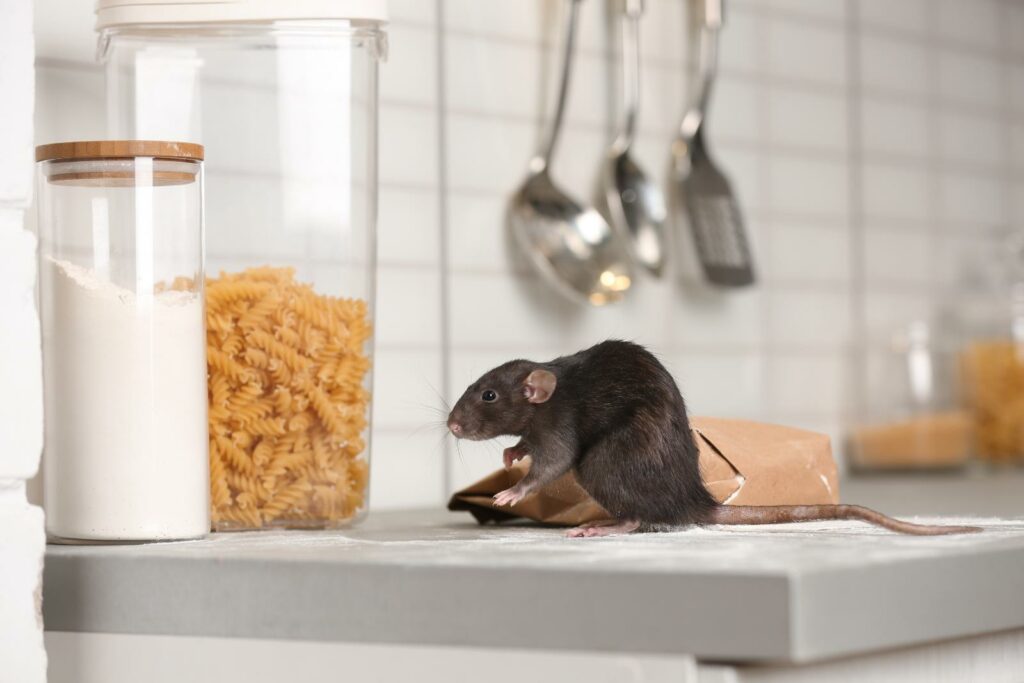
Contents
Imagine walking into your home and being greeted by an unwelcome surprise: a rodent infestation. Like a stealthy intruder, these pests can infiltrate your living space, causing damage and posing health risks.
But fear not, for there is a way to unmask these sneaky creatures and take control of the situation. In this discussion, we will explore the signs of rodent infestations, identify common rodent species, delve into the world of rodent droppings and nesting behavior, and uncover the damages they can inflict.
But that’s not all – we will also guide you through the steps of effective rodent control, ensuring that you regain control of your home. So, strap in and get ready to tackle this challenge head-on.
Key Takeaways
- Rodent infestations can be identified through signs such as droppings, gnaw marks, musky odor, and nests made from shredded materials.
- Rodent droppings vary in size and shape depending on the type of rodent, with mice droppings being small and cylindrical, rat droppings being larger and capsule-shaped, and squirrel droppings being medium-sized and cylindrical.
- Rodents nest in hidden and secluded areas such as attics, crawl spaces, and wall voids, using shredded materials like paper, fabric, insulation, and cardboard.
- Rodents can cause structural damage by gnawing on various materials, contaminating food, spreading diseases, and posing health risks to humans. Implementing effective prevention techniques and rodent control measures, such as sealing entry points, keeping spaces clean, and using traps and baits, is crucial to protect against infestations.
Signs of Rodent Infestations
To identify signs of rodent infestations, carefully inspect your surroundings for any telltale indicators. Rodents are crafty creatures that can invade your space without you even realizing it. By being vigilant and observant, you can prevent a rodent infestation and avoid the health risks associated with it.
One of the first signs of a rodent infestation is the presence of droppings. Rodents leave behind small, dark, cylindrical droppings that can be found near their nesting areas or along their pathways. These droppings can pose serious health risks as they can carry diseases such as Hantavirus and Salmonellosis.
Another indicator of a rodent infestation is gnaw marks. Rodents have a constant need to chew to keep their teeth from growing too long. As a result, they’ll leave behind chewed wires, furniture, and even walls. These gnaw marks not only cause structural damage but can also lead to electrical fires.
You may also notice a musky odor in your home if there’s a rodent infestation. Rodents have scent glands that produce a pungent smell, especially in confined spaces. This odor can be quite strong and unpleasant, making it important to address the infestation promptly.
Additionally, if you spot nests made from shredded materials such as paper or fabric, it’s a clear sign of rodents. These nests are typically found in hidden areas such as attics, basements, or behind appliances. Removing these nests is crucial to prevent a larger infestation.
Common Rodent Species
Rodent infestations can be caused by various common species, each with its own unique characteristics and behaviors. Understanding the habitat and diet of these rodent species is crucial in effectively identifying and treating infestations.
One common rodent species is the house mouse (Mus musculus). These small creatures are found worldwide and are often found in human-made structures such as homes, warehouses, and offices. House mice typically prefer to nest in warm, secluded areas close to food sources. They’re versatile eaters, consuming a wide range of foods, including grains, fruits, and seeds.
Another common species is the Norway rat (Rattus norvegicus). These rats are larger than house mice and are often found in urban areas. Norway rats prefer to burrow in the ground, creating extensive tunnel systems. They’re omnivorous, feeding on a variety of foods, including grains, meats, fruits, and vegetables.
The roof rat (Rattus rattus) is also a common rodent species. They’re excellent climbers and prefer to nest in high places such as attics, trees, and rooftops. Roof rats primarily feed on fruits, nuts, and grains.
Identifying Rodent Droppings
Now, let’s talk about identifying rodent droppings.
When it comes to determining if those little pellets are indeed from rodents, there are a few key points to consider.
First, pay attention to the size and shape of the droppings.
Second, take note of their location and quantity.
Size and Shape
When identifying rodent droppings, pay close attention to their size and shape. Rodents, such as mice and rats, leave behind distinct droppings that can help you determine their presence in your home. The size and shape of the droppings can vary depending on the type of rodent, making it essential to properly identify them. To help you with this, here is a table outlining the typical size and shape of rodent droppings:
| Rodent | Size | Shape |
|---|---|---|
| Mice | 1/8 inch | Small, cylindrical |
| Rats | 1/2 inch to 3/4 inch | Larger, capsule-shaped |
| Squirrels | 1/4 inch to 1/2 inch | Medium-sized, cylindrical |
| Chipmunks | 1/4 inch | Small, pellet-like |
Location and Quantity
To accurately identify rodent droppings, observe their location and quantity in your home. Rodent infestation hotspots, such as dark corners, attics, and basements, are common areas where you can find these droppings. Pay close attention to areas near food sources or where you have noticed signs of rodent activity, such as gnaw marks or chewed wires.
The quantity of droppings can also give you an idea of the severity of the infestation. A large number of droppings scattered throughout your home indicates a significant rodent presence. It’s crucial to address this issue promptly, as rodent droppings can have a detrimental impact on human health. They can contaminate food, spread diseases, and trigger allergies.
Take action to eliminate rodent infestations and ensure a safe and healthy living environment.
Rodent Nesting Behavior
Now, let’s talk about the nesting behavior of rodents. Understanding their nesting habits is crucial in effectively dealing with rodent infestations.
You’ll learn about the materials they use to build their nests, which will help you identify potential nesting sites and take appropriate action to eliminate them.
Nesting Habits of Rodents
Have you ever wondered about the nesting habits of rodents? Understanding their nesting behavior can help you identify potential infestation sites and take necessary precautions.
Here are some fascinating facts about rodent nesting habits:
- Preferred nesting sites: Rodents often seek shelter in hidden and secluded areas. Common nesting sites include attics, crawl spaces, wall voids, and basements.
- Nesting materials: Rodents gather various materials to construct their nests, such as shredded paper, fabric, insulation, and even chewed-up cardboard.
- Nesting habits: Rodents are meticulous nest builders. They create intricate structures using their sharp teeth and agile paws, forming cozy nests to protect and raise their young.
Rodent Nesting Materials
Rodents meticulously gather various materials to construct their nests, utilizing their sharp teeth and agile paws. These resourceful creatures can use a wide range of materials, including shredded paper, fabric, insulation, twigs, leaves, and even bits of plastic or metal. They gather these items from their surroundings, often scavenging through garbage bins or raiding storage areas.
Signs of rodent nesting materials can be found in their burrows, which are typically located in hidden or secluded areas like attics, basements, or wall voids. Look for shredded materials, such as paper or fabric, as well as small twigs or leaves that rodents use to create a comfortable and secure nesting environment.
Identifying these materials can help you determine the presence of rodents and take appropriate action to eliminate them from your living spaces.
Damages Caused by Rodents
One common issue caused by rodent infestations is the extensive damage they can wreak on structures and belongings. When rodents make their way into your home or business, they can cause significant harm, leading to costly repairs and replacements. Here are some of the damages caused by rodents that you should be aware of:
- Structural damage: Rodents have sharp teeth that never stop growing, leading them to constantly gnaw on various materials. This can result in damaged insulation, electrical wires, and even wooden beams, compromising the integrity of your property.
- Contamination: Rodents carry various diseases and bacteria, which can contaminate your living or working spaces. Their droppings, urine, and saliva can spread harmful pathogens, posing serious health risks to you and your family.
- Belonging destruction: Rodents are notorious for their chewing habits, and they won’t hesitate to gnaw on your personal belongings. From furniture to clothing, books, and important documents, nothing is safe from their teeth. This can lead to the destruction of sentimental items and financial loss.
To prevent these damages and protect yourself from the health risks associated with rodents, it’s crucial to implement effective rodent prevention techniques. This includes sealing any entry points that rodents could use to access your property, such as cracks in the walls or gaps under doors. Keeping your living or working spaces clean and free of food sources will also discourage rodents from settling in.
Steps for Effective Rodent Control
To effectively control rodent infestations and mitigate the damages caused, it’s essential to implement proactive measures and follow a comprehensive plan. By taking the necessary steps for effective rodent control, you can create a safe and comfortable environment for yourself and your loved ones.
The first step in effective rodent control is to identify and seal any potential entry points. Inspect your home for gaps, cracks, or holes in walls, roofs, and floors. Rodents can squeeze through even the tiniest openings, so it’s important to seal them off with materials like steel wool or caulk. Additionally, make sure your doors and windows have tight-fitting screens to prevent rodents from gaining access.
Next, eliminate any potential food and water sources. Keep your kitchen and dining areas clean, and store food in airtight containers. Regularly dispose of garbage in tightly sealed bins, and avoid leaving pet food out overnight. Fix any leaks or moisture issues in your home to prevent rodents from accessing water sources.
Implementing traps and baits is another crucial step in effective rodent control. Set up snap traps or live traps in areas where you have noticed rodent activity. Use baits that are specifically designed for rodents, and follow the instructions carefully. Place traps and baits in strategic locations, such as along walls or in areas where droppings or gnaw marks are present.
Regular monitoring and maintenance are essential to ensure long-term rodent control. Continuously inspect your home for signs of rodent activity, and take immediate action if you notice any new infestations. Keep an eye out for droppings, gnaw marks, and unusual noises. It’s also important to maintain cleanliness and proper sanitation practices to discourage rodents from returning.
Summary
So, now you’re armed with the knowledge of rodent infestations. From their sneaky droppings to their destructive behavior, it’s clear that these little creatures aren’t to be taken lightly.
But fear not! With the right steps for effective rodent control, you can show those rodents who their boss is.
So go forth, my friends, and rid your home of these unwanted guests.
Good luck!
Recent Posts
Effective Flea Extermination for Your Pets
Just as a knight must armor up to battle a dragon, you need a solid
What Are Professional Flea Extermination Services?
If you’re dealing with a flea infestation, understanding professional flea extermination services is vital. These
Can You Really Keep Mice Out of Apartments?
Keeping mice out of apartments is more than just wishful thinking. By understanding their behavior
